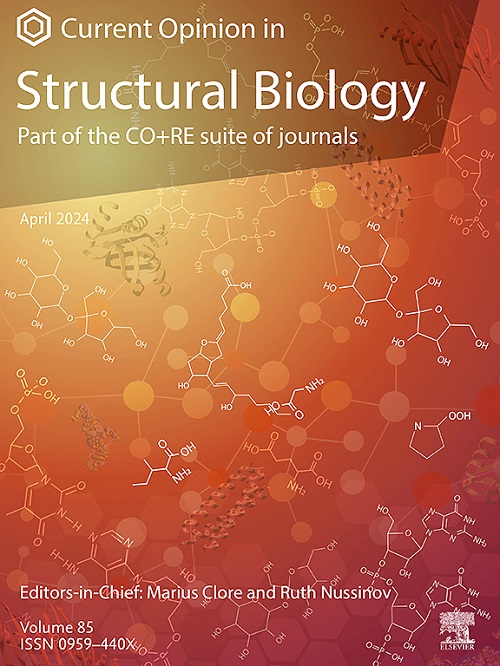HIV-1 gp160 in nanodiscs: Unravelling structures and guiding vaccine design
IF 6.1
2区 生物学
Q1 BIOCHEMISTRY & MOLECULAR BIOLOGY
引用次数: 0
Abstract
The stabilization of HIV-1 gp160 trimers (Env) within phospholipid bilayer nanodiscs has provided critical structural insights into the membrane-proximal external region (MPER) and the broader dynamics of gp160. Cryo-EM and molecular simulations reveal that the membrane context preserves the MPER architecture and captures spontaneous trimer asymmetry, as well as ectodomain tilting. These dynamic properties expose vulnerable epitopes that are targeted by broadly neutralizing antibodies (bnAbs). Studies using nanodiscs have highlighted how interactions with the membrane affect the structure of gp160, the accessibility of epitopes, and the mechanisms of neutralization, providing important insights for immunogen design. Unlike soluble SOSIP and IDL constructs, full-length nanodisc-embedded gp160 maintains its native stability, flexibility, and the complete set of neutralization epitopes, suggesting that membrane-mimicking platforms are essential for the rational design of next-generation HIV vaccines targeting conserved regions, such as the MPER.
纳米圆盘中的HIV-1 gp160:揭示结构和指导疫苗设计
磷脂双层纳米圆盘内HIV-1 gp160三聚体(Env)的稳定为膜近端外区(MPER)和gp160更广泛的动力学提供了关键的结构见解。低温电镜和分子模拟表明,膜环境保留了MPER结构,并捕获了自发的三聚体不对称,以及外畴倾斜。这些动态特性暴露了易受攻击的表位,这些表位是广泛中和抗体(bnAbs)的目标。利用纳米片的研究强调了与膜的相互作用如何影响gp160的结构、表位的可及性和中和机制,为免疫原设计提供了重要的见解。与可溶性SOSIP和IDL构建物不同,全长纳米圆盘嵌入的gp160保持了其固有的稳定性、灵活性和完整的中和表位,这表明膜模拟平台对于合理设计针对保守区域(如MPER)的下一代HIV疫苗至关重要。
本文章由计算机程序翻译,如有差异,请以英文原文为准。
求助全文
约1分钟内获得全文
求助全文
来源期刊

Current opinion in structural biology
生物-生化与分子生物学
CiteScore
12.20
自引率
2.90%
发文量
179
审稿时长
6-12 weeks
期刊介绍:
Current Opinion in Structural Biology (COSB) aims to stimulate scientifically grounded, interdisciplinary, multi-scale debate and exchange of ideas. It contains polished, concise and timely reviews and opinions, with particular emphasis on those articles published in the past two years. In addition to describing recent trends, the authors are encouraged to give their subjective opinion of the topics discussed.
In COSB, we help the reader by providing in a systematic manner:
1. The views of experts on current advances in their field in a clear and readable form.
2. Evaluations of the most interesting papers, annotated by experts, from the great wealth of original publications.
[...]
The subject of Structural Biology is divided into twelve themed sections, each of which is reviewed once a year. Each issue contains two sections, and the amount of space devoted to each section is related to its importance.
-Folding and Binding-
Nucleic acids and their protein complexes-
Macromolecular Machines-
Theory and Simulation-
Sequences and Topology-
New constructs and expression of proteins-
Membranes-
Engineering and Design-
Carbohydrate-protein interactions and glycosylation-
Biophysical and molecular biological methods-
Multi-protein assemblies in signalling-
Catalysis and Regulation
 求助内容:
求助内容: 应助结果提醒方式:
应助结果提醒方式:


